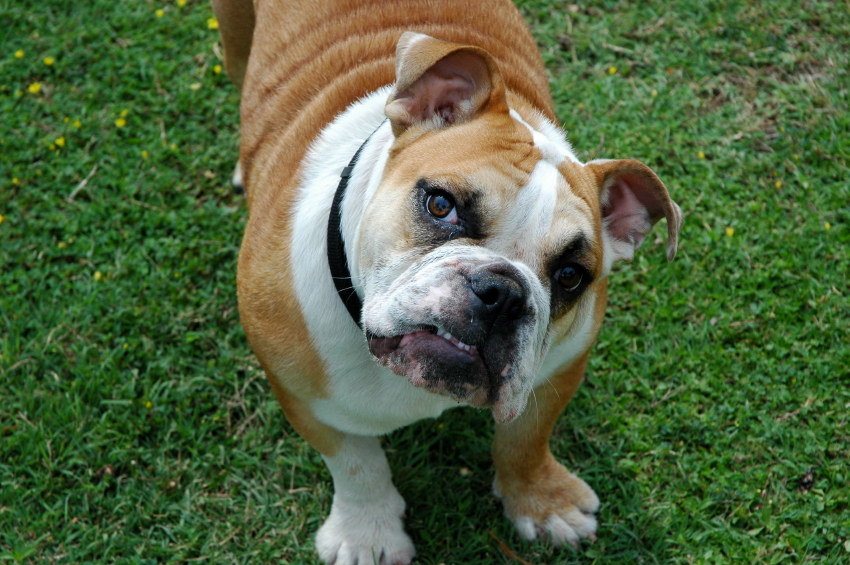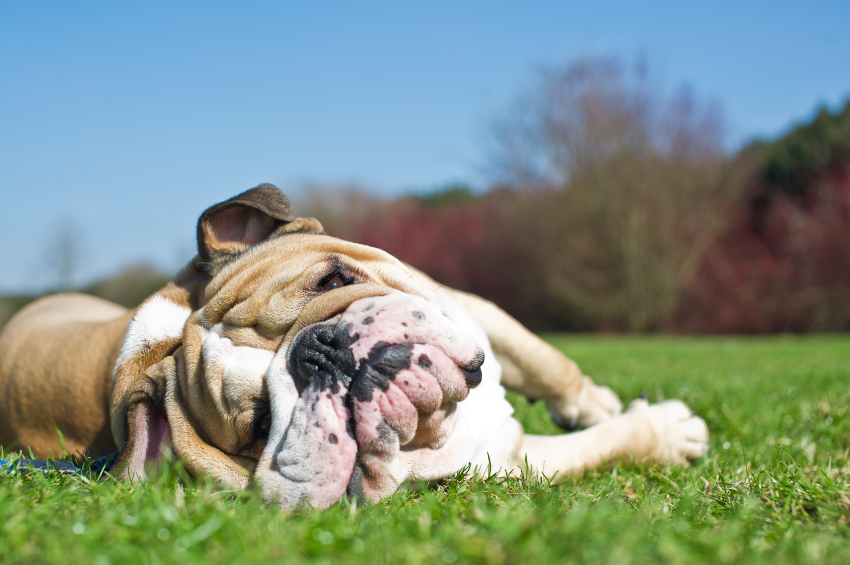Do you have a fat Bulldog? Nearly half of the dogs in the United States are overweight. Unfortunately, Bulldogs are one of the breeds that are prone to obesity. Other breeds that are prone to gaining weight include Dachshunds, Labrador Retrievers, Boxers, Basset Hounds, and Pugs.

Obesity is especially detrimental for brachycephalic dogs, such as Pugs and Bulldogs. The structure of their skeletons and faces already makes it difficult for these dogs to breathe. Excess fat deposits in the chest and airways can further restrict their breathing. This can make them prone to respiratory diseases, including bronchitis.
If you have a fat Bulldog or one that is gaining a few extra layers of skin rolls, here are a few things you must know.
Signs Your Bulldog is Obese
To find out whether your Bulldog is obese, check for the following signs.
The body of a fat Bulldog has no defined shape
Bulldogs are naturally thick, stocky, and roundish to squarish in shape. For this reason, it can be difficult to determine whether your Bulldog is in good shape or not. However, dogs should have waists that are slightly slimmer than their hips. If your Bulldog looks like a chunky sausage, then he is definitely fat.
A fat Bulldog is often unable to scratch his own body
A fat Bulldog tends to have rolls of fat deposits in his body. These fatty layers can inhibit your pet from scratching or licking some parts of his body. Your Bulldog may not be able to scratch his ear using his back paws or any of his paws. He may also have a hard time scratching some parts of his body that he normally scratches using his teeth.
Breathing is even harder for a fat Bulldog
As a breed, Bulldogs have the tendency to snort and pant a lot. But if a Bulldog is fat, his airways tend to get narrower and saggier.
Causes of Bulldog Obesity
Bulldogs are notorious eaters, and they can be very greedy for food. On the other hand, Bulldogs are not known for their love for exercise. The imbalance between diet and lack of sufficient exercise is the main cause of obesity in Bulldogs. High-calorie food and frequent treats also contribute to their weight gain.
Hypothyroidism and neutering can also cause obesity in Bulldogs.
Bad Health Effects: A Fat Bulldog is prone to many diseases
Like an obese human being, a fat Bulldog is prone to the following health issues.
- Increased risk of heat stroke
- Exercise intolerance
- High-blood pressure
- Diabetes
- Liver disease
- Some forms of cancer
- Osteoarthritis
- Increased risk of hip dysplasia
How to Deal with Bulldog Obesity
It can be difficult to make a fat Bulldog lose a few pounds. Because of their physical shape, forcing Bulldogs for hard and long exercises is strongly discouraged. But here are a few things you can do to help your fat Bulldog become fitter.
- Check your Bulldog’s weight. Ideally, a male Bulldog should weigh between 50 to 55 lbs while female Bulldog should be around 47 to 50 lbs.
- Alter your Bulldog’s diet. Look for high-quality but low-calorie dog food for your pet. Feed your Bulldog small meals throughout the day instead of giving him two full meals per day.
- Choose a healthy dog treat. Instead of getting treats from a pet store, try giving your fat Bulldog sliced cucumbers, apples (without the pit), broccoli, celery, green beans, or bananas. Make sure to only give a fat Bulldog a treat after you ask him to do something to earn it.
- Rule out hypothyroidism and other possible health issues. When a dog has hypothyroidism, his thyroid gland fails to produce adequate levels of thyroxine, which is the hormone responsible for converting food to fuel (energy). Without enough thyroxine, your Bulldog’s body is unable to use the food he consumed for his daily activities. If your Bulldog shows signs of hypothyroidism or any health issue, consider taking him to a veterinarian.
- Exercise your Bulldog. Strenuous exercises are not suitable for Bulldogs, especially fat ones, as they get tired easily and are prone to heat stroke. But there are a few Bulldog exercises your pet do. Just make sure not to let your pet overdo them.

